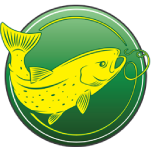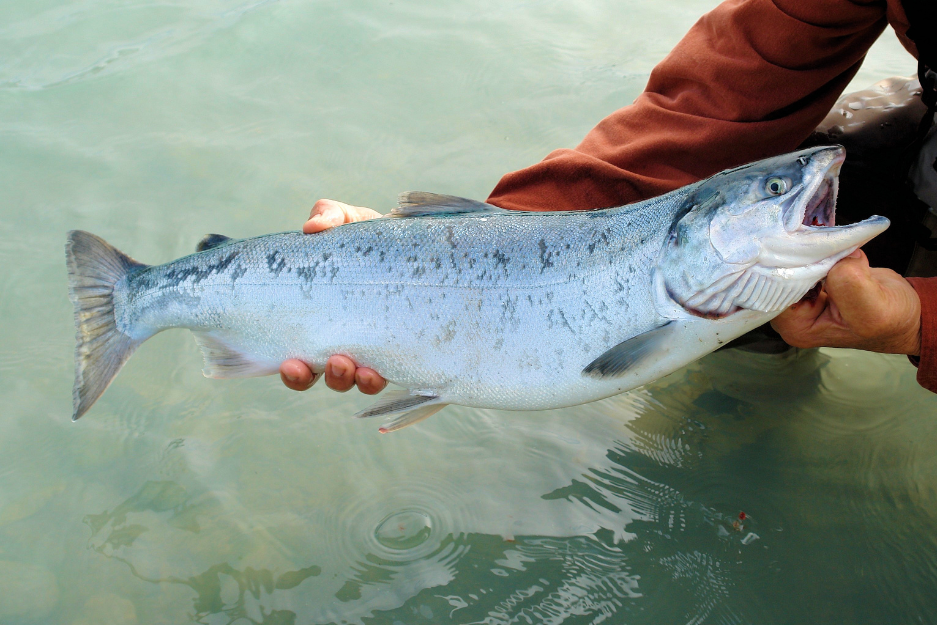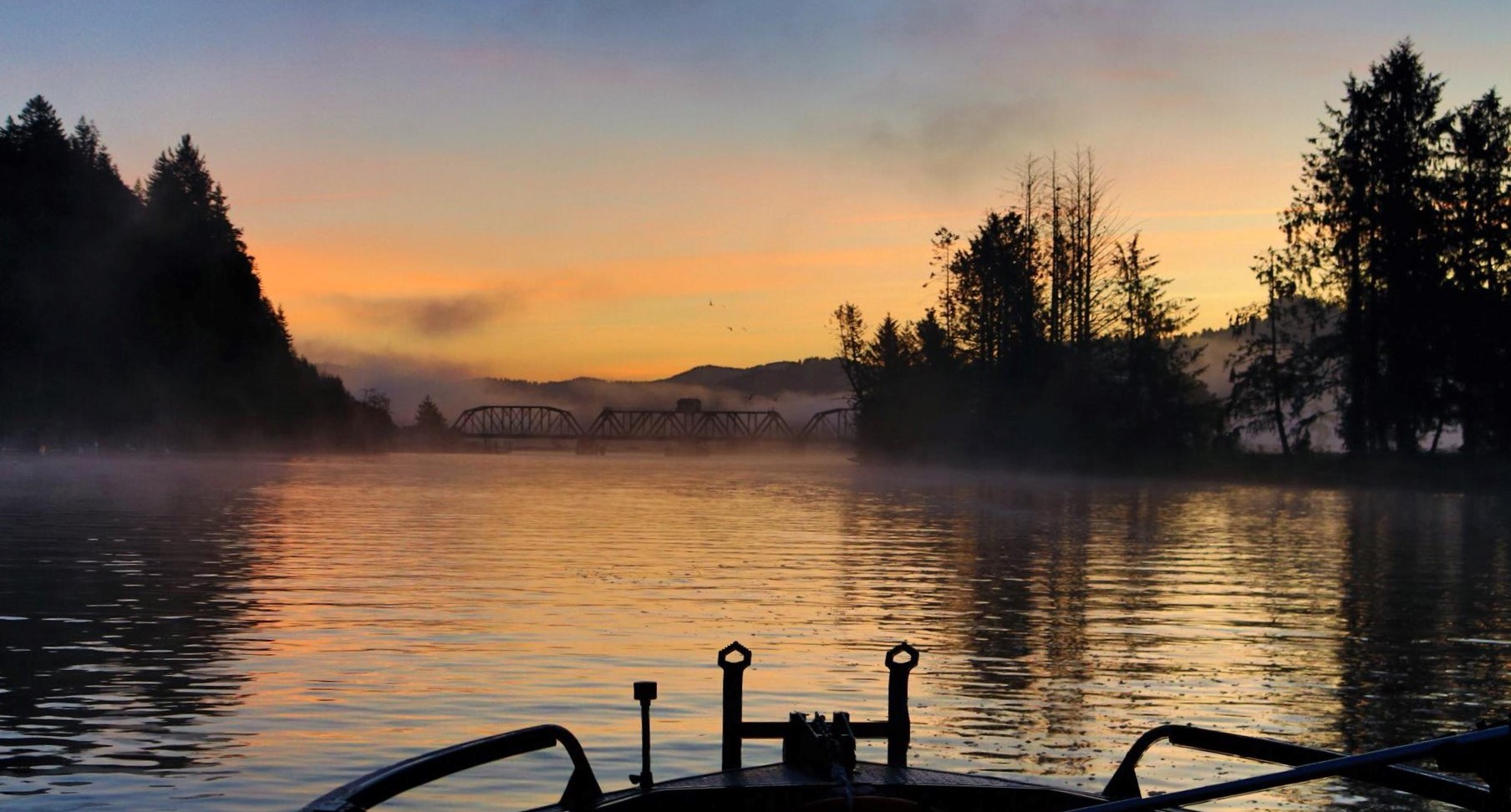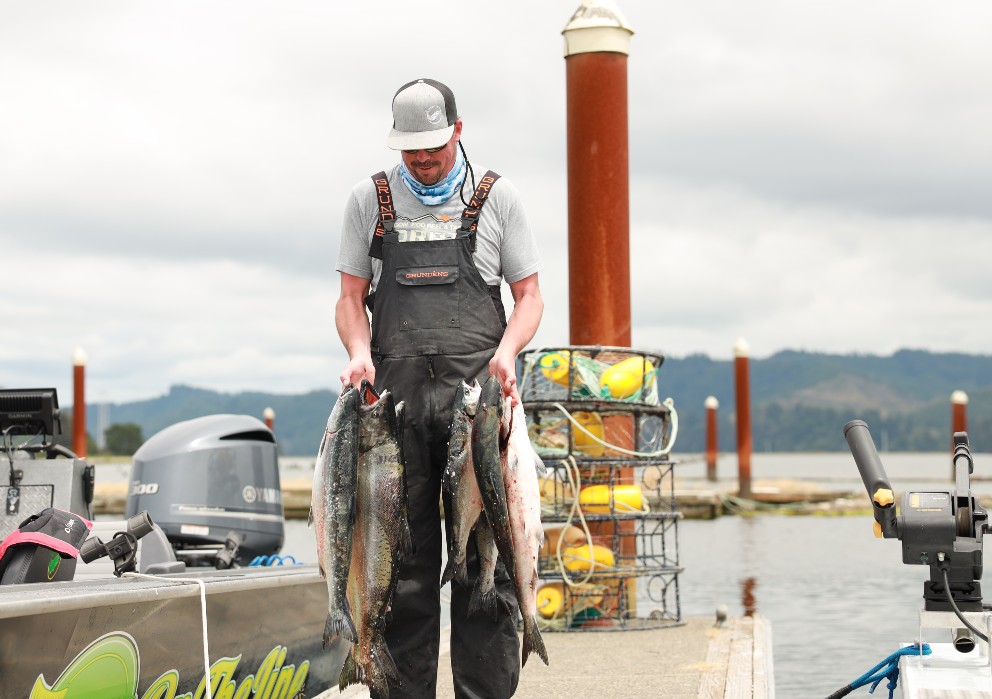As we head into summer ’25, anglers booking a guided charter on the Siuslaw and…

Tucked into Oregon’s central coast, the Siuslaw River is a vital artery for Pacific salmon, particularly Coho (Oncorhynchus kisutch) and Chinook (Oncorhynchus tshawytscha). These two species play essential ecological, cultural, and economic roles in the region. While they often share the same waters, Coho and Chinook differ significantly in their appearance, behavior, habitat preferences, and spawning cycles. Understanding these differences is key for anglers, conservationists, and nature lovers alike.
Physical Characteristics
At first glance, Coho and Chinook may look similar, especially to the untrained eye. However, there are clear distinctions.
- Chinook salmon, also known as “kings,” are the largest Pacific salmon species. In the Siuslaw, they can reach over 30 pounds, though fish in the 15–25 pound range are more common. They are characterized by a black mouth with black gums, large spots on both lobes of the tail, and a thicker body profile.
- Coho salmon, or “silvers,” are generally smaller, ranging from 6 to 12 pounds in the Siuslaw. They have a black mouth with white gums, fewer tail spots (mostly on the upper lobe), and a sleeker, more streamlined body.
During the spawning season, male Coho develop a pronounced kype (hooked jaw) and turn bright red with a darker back, while Chinook males become darker and more mottled, often olive or brownish in hue.
Behavior and Migration
Coho and Chinook follow different timelines for entering the Siuslaw River.
- Fall Chinook begin returning to the river as early as August, with the peak of the run typically in September and October. These fish spend 3–5 years in the ocean before returning to spawn.
- Coho salmon generally begin their upstream migration in late September to early November, with a tighter run window. They usually spend 2–3 years in the ocean.
Habitat and Spawning Preferences
Both species spawn in freshwater gravels, but they select different types of streams and habitat conditions.
- Chinook prefer larger, deeper river channels for spawning and tend to dig their redds (nests) in broader gravel beds with stronger current flows.
- Coho, by contrast, are more likely to spawn in smaller tributaries and side channels with slower flows, where their young will also rear for about a year before heading to the ocean.
This difference in habitat use allows both species to coexist with minimal direct competition.
Fishing for Coho and Chinook
Coho and Chinook follow different timelines for entering the Siuslaw River. These differences affect how and when anglers target them. Fishing for salmon on the Siuslaw River is both a science and an art. Success depends on timing, technique, and sometimes the help of a seasoned guide.
- Best Times to Fish:
- Chinook: Late August through October
- Coho: Late September through mid-November
- Tracking the Fish:
- Salmon are sensitive to tide changes and rain events. After the first big fall rain, both species begin moving upriver more actively.
- Look for them at key holding areas: deep holes, channel bends, and just below the head of tide near Mapleton.
- Best Baits and Lures:
- Chinook: Herring (plug-cut or whole) is a top bait, especially when trolling in tidewater. Spinners (like Blue Fox or Mepps) and Kwikfish are also popular.
- Coho: Brightly colored spinners and twitching jigs (pink or purple) are especially effective. Coho are aggressive and respond well to erratic motion.
- What Fishing Guides Bring to the Table:
- Local knowledge: Guides know the river intimately—including recent fish movements, tide timing, and where fish are holding.
- Gear and setup: A guide will outfit you with the right tackle, bait, and boat positioning—saving you the learning curve.
- Technique coaching: Whether it’s perfecting a twitch or trolling speed, they’ll teach you how to match your technique to the species you’re after.
- Access: Guides often have access to private boat ramps or upriver areas where pressure is lower and the action can be hotter.
Hiring a guide isn’t just for beginners—it maximizes your time and often leads to higher catch rates.
Historical and Conservation Context
Historically, both Coho and Chinook salmon were abundant in the Siuslaw River, supporting Indigenous communities like the Siuslaw and Confederated Tribes of Coos, Lower Umpqua, and Siuslaw Indians for generations. However, logging, road-building, and habitat loss in the 20th century caused dramatic declines, especially in Coho populations.
Today, Siuslaw River Coho are part of the Oregon Coast Coho Evolutionarily Significant Unit (ESU), which is listed as threatened under the Endangered Species Act. Conservation efforts, including habitat restoration and improved land management, are helping to restore runs. Chinook populations, though healthier, are still carefully managed with seasonal fishing regulations to ensure sustainability.
Whether you’re a seasoned angler or a first-timer with a guide at your side, the Siuslaw River offers one of Oregon’s most rewarding salmon fishing experiences. Understanding the key differences between Coho and Chinook—along with the best fishing techniques—will help you make the most of this iconic fishery. Respect the fish, follow the rules, and savor the chance to be part of a tradition that connects river, fish, and people in an enduring Pacific Northwest story.




